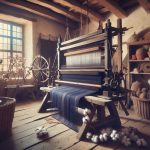Ever wonder why we call it denim? It's all thanks to a fabric from Nîmes, France. Back in the day, they crafted this durable twilled cotton called 'serge de Nîmes,' and well, the name just stuck. But how did this French fabric turn into the global phenomenon of jeans we can't live without? There's a whole journey from its humble beginnings to becoming the backbone of fashion across the world. Stick around, and I'll take you through the fascinating evolution that transformed a simple material into an icon of style and rebellion.
Table of Contents
Key Takeaways
- The term 'denim' originated from the French phrase 'serge de Nîmes', referring to a fabric from Nîmes.
- 'Serge de Nîmes' was a durable twill fabric that evolved into what we know as denim.
- The name was anglicized to 'denim', highlighting its French origins in textile innovation.
- Denim's unique characteristics stem from the twill weave and indigo dye used since its inception.
- The evolution from workwear to fashion staple helped cement the term 'denim' in global vocabulary.
Origins of Denim
The term 'denim' actually comes from the French 'serge de Nîmes,' a tough cotton fabric first made in Nîmes, France. Let me lay it down straight: when we talk about denim, we're diving deep into a rich history that started with this sturdy cotton cloth. Unlike the coarser jean fabric from Genoa, Italy, this was the real deal in terms of durability and quality.
So, what made denim stand out? It's all in the weave and the dye. The twill weave construction of denim, combined with the indigo dyeing process, gives it that iconic blue color and distinct texture that we've all come to know and love. This wasn't just any fabric; it was a game-changer in fabric technology.
Weavers in Nîmes were onto something big, crafting a version of blue cloth that wasn't just for workwear but was built to last. This evolution from a practical fabric into a global fashion staple is what makes denim's history so fascinating. It's not just about the warp yarn or the cotton cloth; it's about how innovation transformed a simple idea into a worldwide phenomenon.
Serge De Nîmes Evolution
So, let's talk about how serge de Nîmes, or what we now call denim, has changed over time.
It all started in France, where this durable fabric caught everyone's eye for its quality.
Then, it went on quite a journey, transforming into the everyday material we can't seem to live without.
Origin in France
Delving into its origins, it's fascinating to learn that denim's journey began with the French fabric 'serge de Nîmes,' crafted in Nîmes, France. This sturdy blue cloth, developed by weavers in the 17th century, laid the groundwork for what we now recognize as denim fabric.
The term 'denim' itself is a nod to its French roots, a shortened version of 'serge de Nîmes.' It's incredible to think that this fabric, originally designed for durability, has evolved from high-quality workwear to a cornerstone of fashion.
The French connection isn't just a trivia fact; it highlights Nîmes' significant role in the development of this versatile material. It's a testament to the enduring legacy of 'serge de Nîmes' in the world of denim.
Fabric Transformation Journey
Let's explore how 'serge de Nîmes' evolved into the denim we know and love today. This fabric's transformation journey is nothing short of fascinating.
Originating from the French city of Nîmes, 'serge de Nîmes' was a sturdy blue cotton cloth praised for its unique characteristics and quality. It didn't take long for its name to get shortened to 'denim,' making it easier to reference and adopt globally. This abbreviation wasn't just about convenience; it signified the start of denim's global journey, underpinned by French textile innovation.
The evolution from 'serge de Nîmes' to the durable fabric we're obsessed with today marks a crucial milestone in fashion history, showcasing the importance of quality, durability, and innovation in creating timeless workwear.
Indigo Dye and Color
Indigo dye is the hero behind denim's iconic deep blue color, giving it those unique fading charms we all love. This magical substance has been the backbone of denim's allure, historically praised for its rich blue shades that have captivated wardrobes worldwide. I've always been fascinated by how this particular dye, especially the synthetic indigo introduced in 1878, has dominated the denim scene. It's not just about the deep blue hue; it's the colorfast properties that really seal the deal. These properties ensure that denim doesn't just fade willy-nilly but develops a character over time.
What's truly mesmerizing is the unique fading process. Denim, with each wear, becomes a canvas, capturing moments and movements. This isn't something you get with just any fabric or dye. It's the indigo dye's magic at play, transforming standard clothing into pieces laden with memories. The blend of synthetic indigo's longevity and the inherent fading properties creates denim that not only looks better with age but tells a story. It's a testament to how the right dye can elevate a fabric from ordinary to extraordinary.
Levi Strauss & Co. Foundation
So, let's talk about the Levi Strauss & Co. Foundation. They're not just about making jeans; they've got a history of doing good stuff, like giving back through philanthropy and pushing for environmental sustainability.
It's pretty cool how a company that started with riveted pants is now also focused on making the world a bit better.
Early Company History
I'll dive right into how Levi Strauss, a Bavarian immigrant, kicked off his venture in 1853, laying the foundation for what would become a denim empire.
Starting with a dry goods business, Strauss was all about selling clothing, fabrics, and other essentials. But the real game-changer came in 1873 when he and Jacob Davis patented riveted denim pants. This wasn't just another piece of clothing; it was a revolution in the workwear industry.
Philanthropic Endeavors
After exploring the remarkable journey of Levi Strauss and the birth of denim, let's shift gears and look at the company's philanthropic side through the Levi Strauss & Co. Foundation. Established in 1952, this foundation is all about giving back, focusing on areas like education, social justice, and HIV/AIDS prevention.
They aren't just about writing checks; their commitment runs deep into sustainability, ethical sourcing, and creating a positive social impact through partnerships with non-profits. Their philanthropic efforts are a big part of their identity, emphasizing community engagement and stepping up as a responsible corporate citizen.
It's clear the Levi Strauss & Co. Foundation isn't just an add-on; it's at the heart of what they stand for, blending their love for denim with a dedication to making the world a better place.
Environmental Sustainability Initiatives
The Levi Strauss & Co. Foundation is diving deep into making denim's future greener with their environmental sustainability initiatives. They're tackling big issues in the denim industry head-on. We're talking reducing water usage, which is huge because denim can be pretty thirsty. Then there's pushing for sustainable cotton farming. It's not just about using less water; it's about farming smarter, with less impact on our planet. And don't get me started on garment recycling – it's a game-changer for cutting down waste.
They're also on a mission to slash carbon emissions. It's all about minimizing the environmental footprint of denim production. By collaborating with partners, they're driving sustainable practices right through the denim supply chain. It's innovative work aiming for a much greener, sustainable future for denim.
Denim's Role in Fashion
Over the years, denim's journey from workwear to a fashion staple has been nothing short of remarkable. Back in the day, it was all about durability, but then folks like Elvis Presley and James Dean turned it into a symbol of cool. This wasn't just by chance. Companies like Levi Strauss and H.D. Lee were on the ball, tweaking their designs to ride the wave of these emerging fashion trends. They knew they'd something more than just tough pants for miners and cowboys.
What makes denim stand out, really, is its unique blend of yarn characteristics, that classic indigo dye, and the way it's all woven together. These elements give denim its distinct look and feel, allowing for an endless variety of styles. Whether it's the rugged charm of a well-worn pair of jeans or the sleek look of indigo-dyed fashion items, denim keeps reinventing itself.
The thing is, it's not just about looking good. The texture, the wear over time, how it fades – everything about denim tells a story. And that's why it's stayed at the heart of fashion trends for so long. It's more than fabric; it's history, it's personality, it's art.
Technological Advancements
As denim's journey has evolved, so have the tech advancements that make our favorite jeans even better. We're not just talking about any twilled cotton here; this is about pushing boundaries in the denim market with innovations that have truly changed the game.
Take the broken twill weave, for instance. It's a clever twist on the traditional, aimed squarely at preventing that annoying leg twist and reducing fabric pulling. It's these kinds of thoughtful upgrades that keep our jeans looking sharp and fitting just right.
Then there's the whole science of denim dyeing processes. These have been fine-tuned to the point where color retention and fading properties are more controlled than ever. That means the cool, lived-in look we all love doesn't come at the cost of the jeans losing their character too quickly. Plus, the variations in twill weave patterns not only add to the visual appeal but also enhance fabric durability.
It's clear that technological advancements in how denim is woven and dyed are major players in how our jeans feel and age. The focus isn't just on looks; it's about crafting denim that stands the test of time while keeping those iconic styles we all crave.
Denim's Global Influence
Denim's journey from French workwear to a global fashion icon truly showcases its universal appeal. It's fascinating how this rugged fabric, with its French origins, morphed into a worldwide phenomenon. Here's a snapshot:
- Levi Strauss & Co. played a pivotal role in denim's history, introducing it to the American market in 1860. This move was crucial in denim's transition from workwear to fashion staple.
- The fabric's association with American culture and Hollywood icons like Elvis Presley and James Dean cemented its cool status. These figures made denim synonymous with rebellion and freedom.
- Denim's versatility has made it a darling among fashion designers worldwide, constantly reimagined in countless styles, washes, and finishes.
- Today, the global denim market is worth billions, with brands and consumers increasingly focusing on sustainability initiatives to reduce the environmental impact of denim production.
Denim's global influence is undeniable. From its humble beginnings to becoming a staple in closets around the world, its story is a testament to the enduring appeal of quality, style, and innovation. As we look forward, it's clear denim will continue to shape our global fashion landscape.
Frequently Asked Questions
Why Is Denim Called Jeans?
I've always wondered why denim is called jeans. Turns out, it's from the French word 'genes,' referring to the fabric's origins in Genoa, Italy. Levi Strauss & Co. made the term popular in the 1950s.
What Is the Difference Between Denim and Jeans?
I've learned that denim is the fabric, while jeans are the pants made from it. They're not the same though often mixed up. Denim's used for various items, but jeans specifically refer to the style.
Why Do We Say Jeans and Not Jean?
We say 'jeans' instead of 'jean' because it's become the standard way to refer to these denim pants. It's a habit that's stuck, showing how language evolves with fashion and popular culture.
Does Denim Have to Be Blue?
No, denim doesn't have to be blue. While its classic look is deep blue from indigo dye, nowadays, you'll find denim in a rainbow of colors, offering way more versatility in fashion choices.
- How Does Ring Spun Cotton Affect Garment Fit and Shape Retention? - August 13, 2024
- What Are the Challenges in Producing Ring Spun Cotton? - August 13, 2024
- Is Ring Spun Cotton Suitable for Plus-Size Clothing? - August 13, 2024







